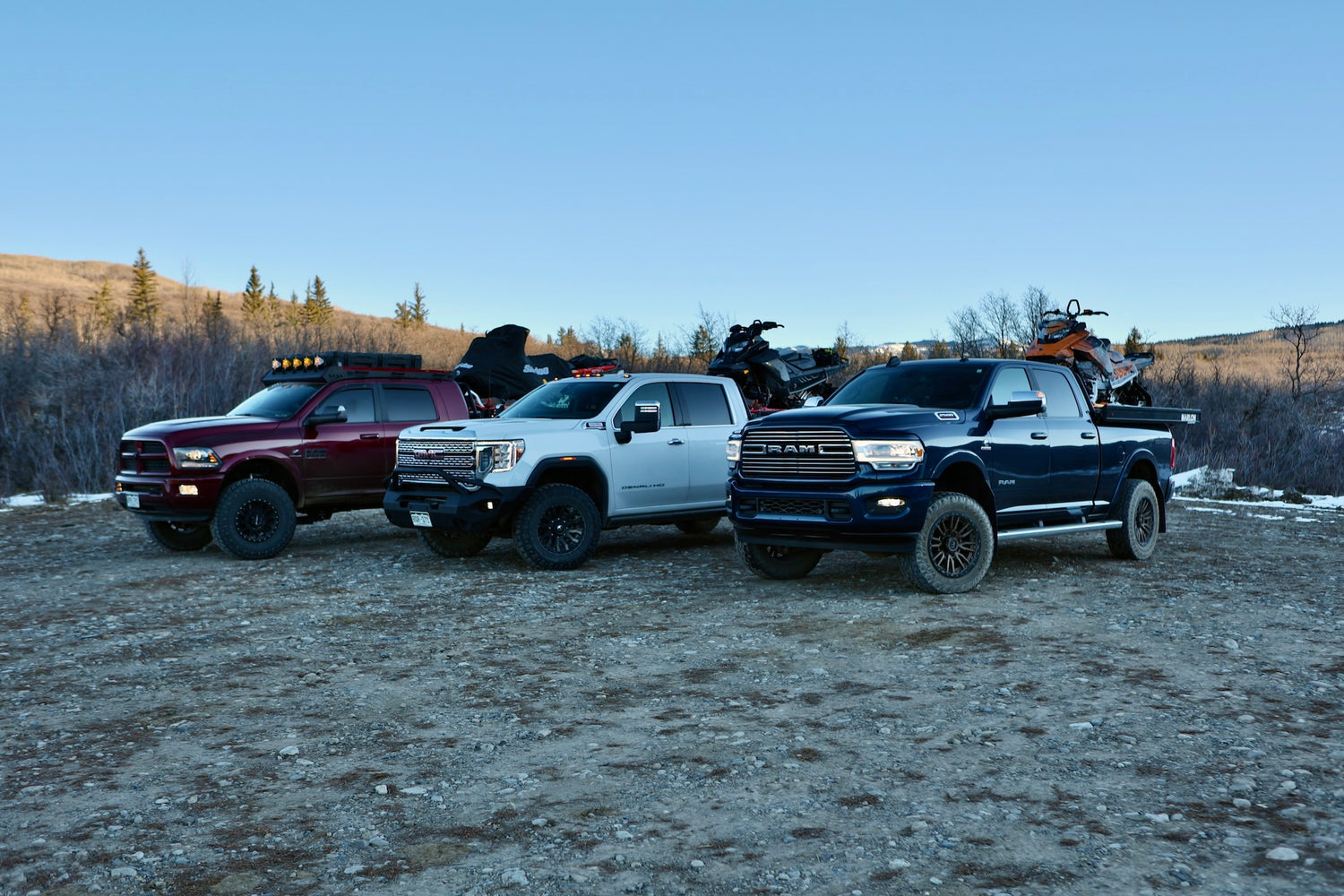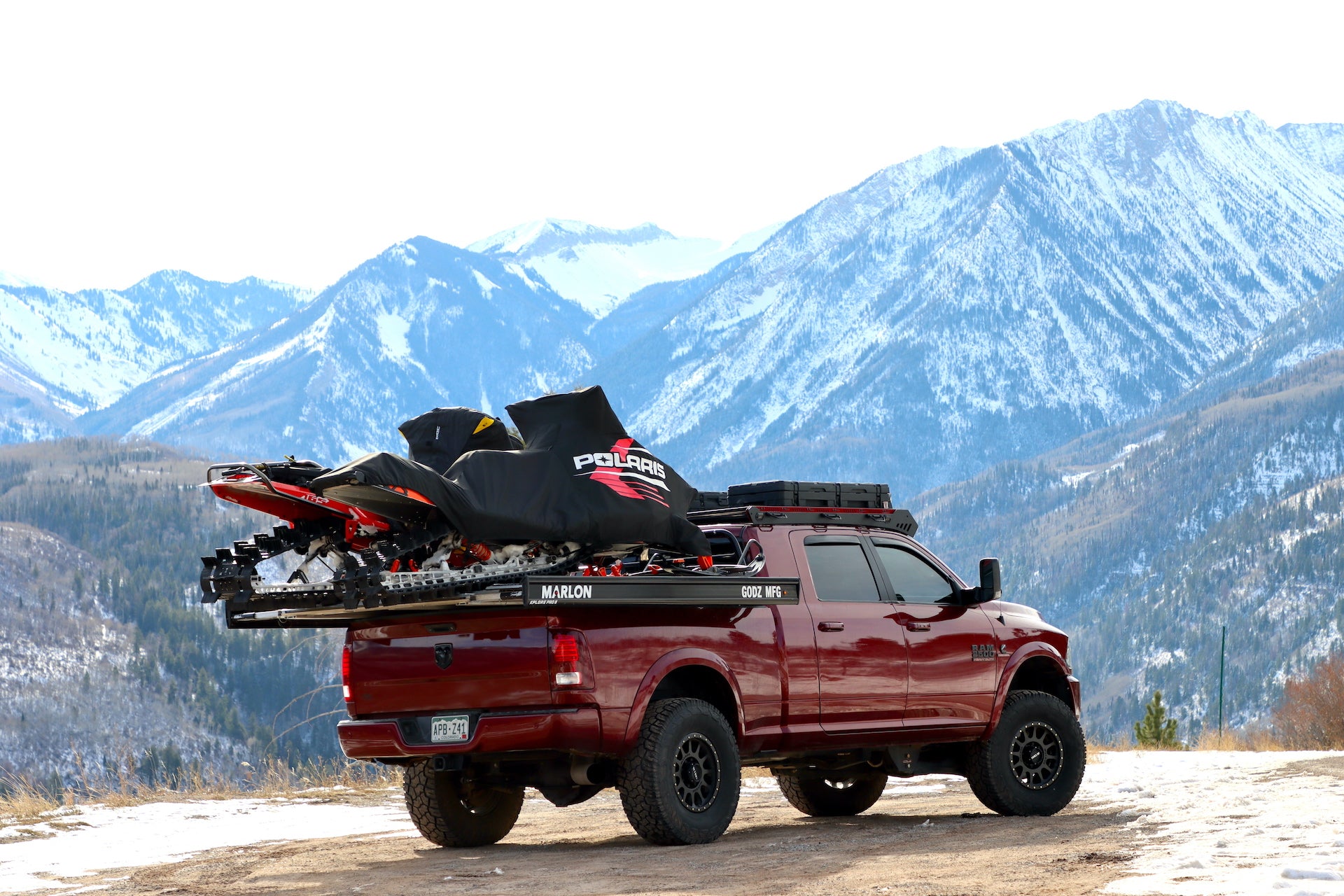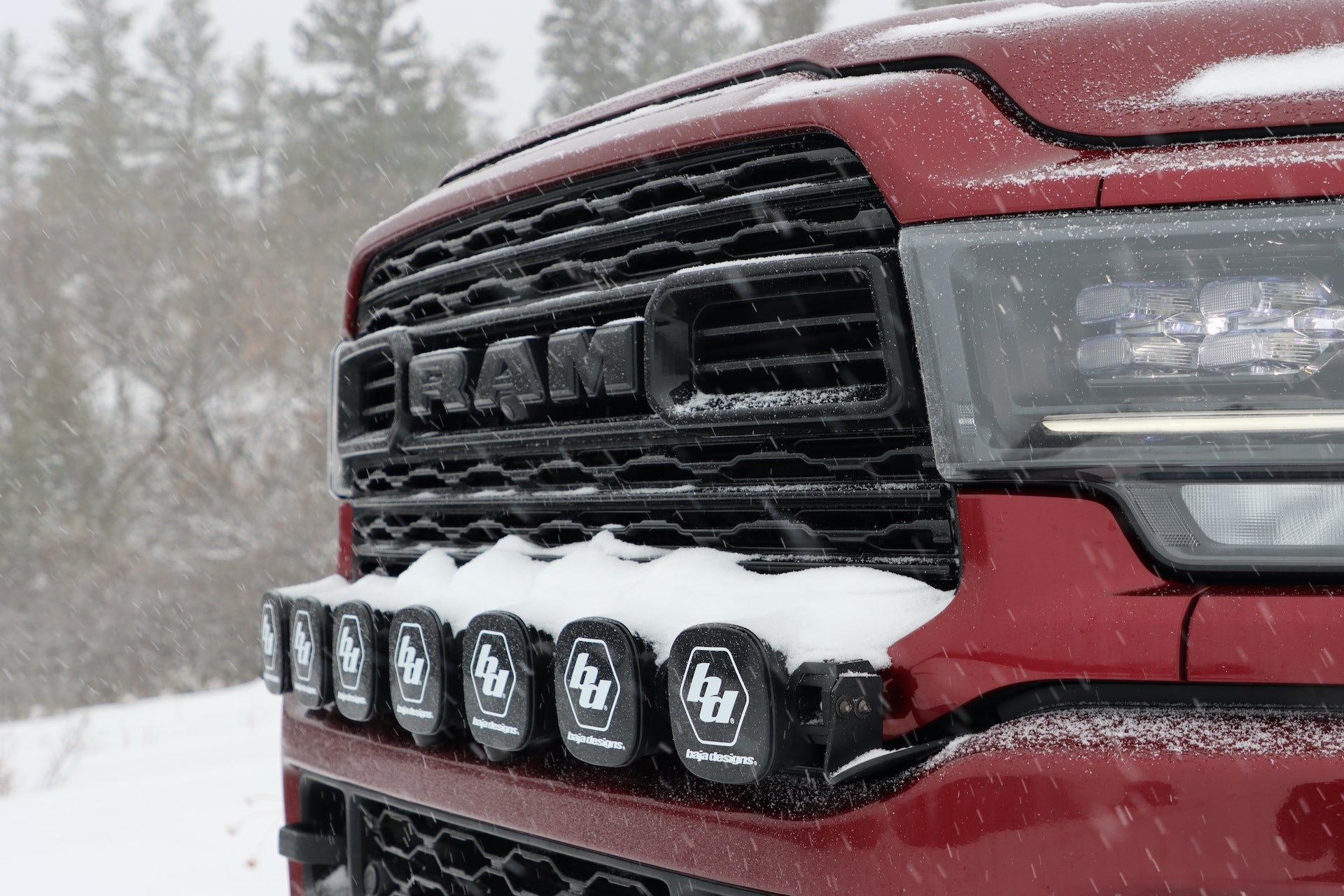GODZ MFG - Castle Rock, CO
Which Full-Size Truck is Best for Off-Roading? Comparing 1/2 Ton, 3/4 Ton, and 1 Ton Trucks
FULL-SIZE Friday Blog: Week 2
What this post will cover:
½ ton, ¾ ton, or 1 ton? F-150, RAM 2500, or a GMC 3500? What is the best size truck for you and your overland adventures? If you read last week’s blog, you’ll know that I owned a Tacoma at one point in time too. If you missed it, you can find it HERE. This week’s blog is designed to cover what truck will best suit you off road. We’re not going to discuss the mid-size contenders as those are not really our specialty here at GODZ MFG.
There is a lot to consider when purchasing a new truck, especially given the fact that some of the new trucks can easily top $100,000 and that is not a purchase you want to make lightly. That’s not to say that you need a brand new truck to start your adventures, but nonetheless, the decision is important and not one that you should take lightly. We’re going to do our best to help steer you through the sizes of trucks today and over the next few weeks we'll talk about the pros and cons of the specific brands themselves.
½ Ton Trucks
We’ll start with the smallest of the full-size trucks, the ½ tons, otherwise known as the Ford F-150s, RAM 1500s, Chevy and GMC 1500s, and the Toyota Tundras of the world. These trucks fit the bill for MANY truck owners and are the most popular trucks on the road today for that reason.
The first thing we will mention is payload. Payload is the capacity of weight that your truck can carry. The payload factors in the weight of the guests in the cab of the truck in addition to any gear that you may load into the bed. The payload capacity for your ½ ton trucks can range from 1,238 pounds on the low end to 2,335 pounds on the high end (based on 2022 model year numbers from all major manufacturers.)
There are a lot of factors that affect the payload. The two main drivers for payload are engines and accessories. A bigger V8 engine may have more power but it generally will weigh more too. The increased weight of the engine will then in turn diminish the overall payload capacity. The same principle applies to accessories. Options like power steps, dual batteries, Ram Boxes and even options as small as more speakers, generally included in a premium trim level, will diminish the payload rating. A general rule of thumb, the more bells and whistles your truck is equipped with, the less gear (payload) you can haul around.
Understanding payload is just as important as understanding horsepower and torque. So what does the ½ ton truck and its payload equate to in a car camping or overlanding scenario? This size truck is going to be ideal for camping setups like a roof top tent or a lightweight truck camper. Your typical bed rack and roof top tent generally will not weigh more than about 350 pounds. Truck campers, like a Lone Peak Overland, Go Fast Camper, or Super Pacific also weigh around that same 350 pound mark. Sleeping systems like this will allow for a comfy night of rest, but still leave plenty of carrying capacity for occupants and other gear without maxing out your payload.
Your ½ ton truck has some distinct benefits when compared to their bigger brothers like the ¾ and 1 ton trucks.
For one, size. The ½ ton trucks tend to have a shorter wheelbase and are also typically narrower. This smaller size helps these trucks work down tight trails more easily. Don’t let the smaller exterior deter you, however. Most of the modern ½ ton trucks still have plenty of interior space with comfortable cockpits and still plenty of room in the back seat for a full-size man to sit comfortably.
½ ton trucks also err on the side of being more fuel efficient too. It used to be that you bought a mid-size truck for fuel efficiency, but I can tell you from experience that’s a joke. Even my stock Tacoma only ever saw about 18 mpg on Colorado’s Front Range. New ½ ton trucks are getting anywhere from 20-26 mpg highway with the RAM 1500 EcoDiesels leading the pack. You also have options like the Toyota Tundra which are now offered in a hybrid to squeeze every mile thinkable out of as little dinosaur juice as possible.
I’d say the last notable advantage of a ½ ton truck is their price. Sure, a Platinum F-150 or GMC AT4X 1500 can top $85,000 in today’s market, but the flip side of this is you can still find new ½ ton trucks for around $30,000 if you are willing to give up leather and 17 speakers.
¾ Ton Trucks
Departing from ½ ton trucks, your next jump is to a ¾ ton truck like a RAM 2500, Chevy 2500, GMC 2500, or a Ford F-250. Every American truck company makes a ¾ ton truck and many of these manufacturers are beginning to offer off road oriented trim levels as the market continues to evolve. Some examples are the Ford Tremor or Chevy/GMC AT4X. The ¾ ton trucks bridge the gap for many consumers by offering increased payload, increased towing capacity, and 5th wheel/gooseneck capability while still maintaining supreme comfort for long haul trips in a relatively ‘unloaded’ truck.
A lot of people tend to say or believe that HD trucks aren’t comfortable, or that they have a harsh ride. While this can be true, it’s not absolute. Payload capacity on ¾ ton trucks ranges from 2,462 pounds on the low end to 4,323 pounds on the high end (based on 2022 model year numbers from all major manufacturers.) With a minimum payload rating topping a ½ ton max payload rating, the suspension and axles of a ¾ ton truck are going to need to be significantly beefed up when compared to their smaller brothers. This is where the ‘stiff ride’ and ‘harsh driving’ comments tend to come from.
Comfort is relative, however. If you’ve gone from a Porsche Panamera designed for suburban soccer moms to a Ford F-250, yes, the ride is going to be harsh, however an F-250 is designed and built with a different customer in mind.
So where exactly does a ¾ ton truck fit in off road? 5 years ago? Nowhere. However, today you will see quite a lot of ‘built’ HD trucks cruising through mountain towns like Ouray, CO and desert escapes like Moab, UT.
There is no question that the ¾ ton trucks are a big jump in size over the ½ ton trucks, just ask anyone that has earned their ‘Colorado Pinstripes’ on some skinny, forgotten mining road that was cut for a horse and buggy at the turn of the century. A few inches in overall width and a foot or so added to the wheelbase can drastically affect the ‘nerves’ of a driver in this type of environment. For some, this is 100% worth it, including myself and Grant.
Much like the ½ ton trucks, car camping can be made easy with a bed rack and roof top tent or a camper like the Lone Peak, Go Fast, or Super Pacific. Weighing in around 350 pounds, these trucks wouldn’t even notice that weight. With the increased payload capacity you could begin to look at campers like the Four Wheel Campers Project M Topper or the AT Overland Habitat Camper both weighing in around 450-500 pounds. If you pack carefully and travel light, you could even look at smaller slide-in campers like the Four Wheel Campers Fleet and Granby models that will weigh between 1200-1600 lbs depending on options.
The ¾ ton trucks are also nice from a size perspective. With a minimum bed length of 6.5’ on most HD trucks, there is a whole lot more room for activities. Most of us have our ‘base’ or ‘essential’ camping gear that always comes with us. In my Tacoma, this consumed the entire truck bed. In my RAM, I have room for all of my base gear in addition to biking gear, cornhole boards and a paddleboard if I was really so inclined to schlup all of this crap around.
I touched on roomy interiors in the ½ ton trucks, but just wait until you jump in a ¾ or 1 ton truck, they’re HUUUGE. While most of your creature comforts will remain relatively unchanged, the over space and comfort is definitely an upgrade.
Another major pro to a ¾ ton truck is an optional diesel. While some ½ tons are offered with a diesel upgrade, it is standard to have this option offered in the ¾ tons. Sure, you can still get a HEMI in a ¾ ton truck, but no country artist is going to sing about a gas motor when they can talk about a Cummins or a Duramax. Modern diesels run uber-efficient on the highway too and have a seemingly endless amount of power making them optimal for a long road trip over varying terrain.
Overall, the jump from a ½ ton to a ¾ ton truck is fairly straightforward, however, the jump should be warranted by the intended and desired use of the truck. ¾ ton trucks are going to be a $20,000 dollar jump on the low end with most of these trucks starting around $50,000 and easily topping out over $100,000 depending on the trim levels and options you select.
1 Ton Trucks
Lastly, we have the 1 ton trucks. This section will be fairly brief as the 1 ton trucks share much more in common with a ¾ ton truck, than a ¾ ton truck shares with a ½ ton truck. Your major difference in a 1 ton truck compared to a ¾ ton truck is payload. Outside of payload, these trucks generally share the same interior features, drivetrains, looks, frames, and much more, but once again, payload is something that needs to be heavily considered when selecting the right truck for you.
Payload capacity on 1 ton trucks ranges from 3,891 pounds on the low end to 7,680 pounds on the high end (based on 2022 model year numbers from all major manufacturers.) Yet again, this is a big jump over its smaller brother, in this case, a ¾ ton truck.
So what do you carry that weighs 7,680 pounds? Hopefully not any single item, but it will certainly allow you to tote around a massive slide in camper and a whole bunch of other gear as well. The 1 ton trucks are going to be best suited for large slide-in campers like a Palomino that could easily top 4,000 pounds depending on options. That being said, even with this absurd payload capacity, a lighter and more agile Four Wheel Camper would still be at home on a 1 ton truck, but you could splurge and outfit your truck with something like a Bowen Customs or Norweld Flatbed and a Hawk Flatbed camper.
How to decide?
So what’s the right size truck? Well that’s up to you to decide. There should be a ton of research that goes into planning your build. Our advice is to read a lot, attend shows like Overland Expo, watch YouTube, scroll Instagram, and really determine what you WANT as it pertains to a camping setup. From there, research the individual products and determine what you NEED as it pertains to a truck. Keep payload, size, power and comfort in mind as you make your decision.
We hope this helps, but if you still want help, or really want to nerd out, contact us!
Thanks for reading and we’ll see you next week!




Leave a comment
This site is protected by hCaptcha and the hCaptcha Privacy Policy and Terms of Service apply.